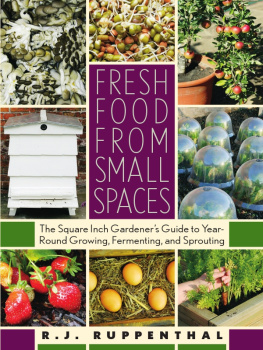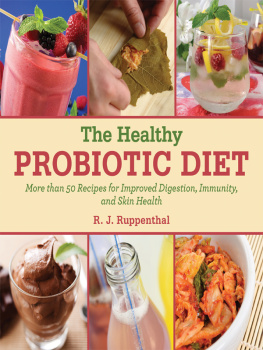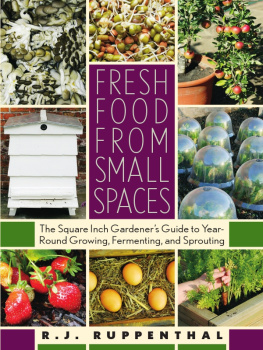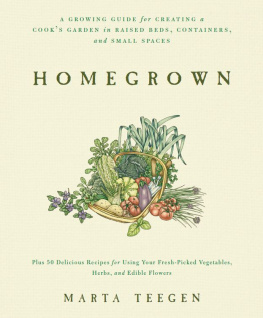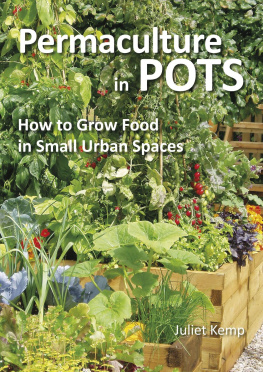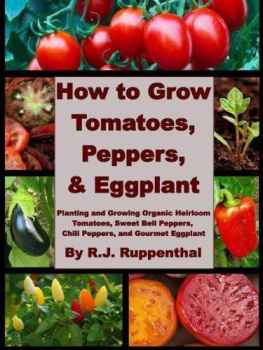
FRESH
FOOD
FROM
SMALL
SPACES
FRESH
FOOD
FROM
SMALL
SPACES
The Square Inch Gardeners
Guide to Year-Round Growing,
Fermenting, and Sprouting
R. J. RUPPENTHAL
Chelsea Green Publishing Company
White River Junction, Vermont
Copyright 2008 by R.J. Ruppenthal.
All rights reserved.
No part of this book may be transmitted
or reproduced in any form by any means
without permission in writing from
the publisher.
Project Manager: Emily Foote
Developmental Editor: Ben Watson
Copy Editor: Susan Barnett
Proofreader: Ellen Brownstein
Designer: Peter Holm, Sterling Hill
Productions
Printed in the United States of America
First printing, September 2008
10 9 8 7 6 5 4 3 2 1 08 09 10 11
Our Commitment to Green Publishing
Chelsea Green sees publishing as a tool for cultural change and ecological stewardship. We strive to align our book manufacturing practices with our editorial mission and to reduce the impact of our business enterprise on the environment. We print our books and catalogs on chlorine-free recycled paper, using soy-based inks whenever possible. This book may cost slightly more because we use recycled paper, and we hope youll agree that its worth it. Chelsea Green is a member of the Green Press Initiative (www.greenpressinitiative.org), a nonprofit coalition of publishers, manufacturers, and authors working to protect the worlds endangered forests and conserve natural resources.
Fresh Food from Small Spaces was printed on 60-lb. Joy White, a 30-percent postconsumer-waste recycled paper supplied by Thomson-Shore.
Library of Congress Cataloging-in-Publication Data
Ruppenthal, R. J.
Fresh food from small spaces : the square-inch gardeners guide to year-round growing, fermenting, and sprouting / R.J. Ruppenthal.
p. cm.
Includes bibliographical references.
eBook ISBN: 978-1-60358-145-5
1. Square foot gardening. 2. Container gardening. 3. Small gardens. I. Title. II. Title: Square-inch gardeners guide to year-round growing, fermenting, and sprouting.
SB453.R87 2008
635--dc22
2008026557
Chelsea Green Publishing Company
Post Office Box 428
White River Junction, VT 05001
(802) 2956300
www.chelseagreen.com
TABLE OF CONTENTS
T his book is a practical guide to growing food for city residents with small spaces. It provides you with the knowledge and skills necessary to produce food from your own fresh vegetables and fruits, mushrooms, sprouts, fermented foods, and small livestock. Even if you have no yard and very little free space, you can produce a variety of fresh food. Using the information in this book, I believe that anyone living in a typical city apartment, condominium, townhouse, or single-family home could apply just two or three of the strategies mentioned in this book and grow up to 10 to 20 percent of their own fresh food. This may sound impossible, but its very achievable by using a combination of traditional methods and innovative, space-saving techniques. At the end of the day, you may even have enough eggs, spinach, blueberries, or gourmet mushrooms to share or trade the excess with neighbors. In short, this book is about using every square inch of your available space to create a fresher and more sustainable lifestyle.
I know firsthand of the need for this book, because I have been searching for it for many years. Having lived in small urban apartments and condos, I did not have the luxury of space that most gardening books describe. When I looked for a guide to raising food in the city, all I found were glossy coffee-table books with beautiful pictures of flowers and herbs growing in containers on somebodys porch. A handful of others discussed what to do with a large backyard, but what if you have no backyard? So I turned to rural sustainability guides and organic gardening manuals, I improvised, and I learned from others who were practicing techniques that could be applied in small spaces. I have now practiced, or observed firsthand, each of the food-producing techniques in this book. By trying, failing, and sometimes succeeding, I have learned how to produce a sizeable percentage of my familys own fresh food from a small urban living space. And I decided that others could use this information too, so I wrote the book I had been trying to find.
There is another important rationale for this book, at this time. The world is changing quickly and we need to adapt. For the last few generations, our entire economy and way of life, in addition to our food supply, have been built on a steady supply of cheap energy. We have not needed to worry much about where our food comes from or how far we need to drive to work. But in the coming years this foundation of cheap energy is likely to disappear, and our lives will change dramatically as a result. In the words of Kenneth Deffeyes, a former Shell petroleum geologist and current Princeton University professor, Global oil production will probably reach a peak sometime this decade. After the peak, the worlds production of crude will fall, never to rise again. If the predictions are correct, there will be an enormous effect on the world economy. Once an oil wells production peaks, it is much more expensive to pump out what remains, not to mention the rapid decline in overall production, which is the situation we face today with the worlds biggest oil wells. Everything we buy and use, from clothes to food to electronics to lumber, is made using these fossil fuels for production, manufacturing, shipping, and more. When the price of oil and gas goes up, everything else follows. The increases we have seen so far are only the beginning.
Mainstream companies now understand that cheap oil is disappearing, and that it will cost much more to obtain, refine, and transport the oil that remains. According to an ad from Volvo, global oil production will probably peak within the decade, and the time of cheap and abundant crude oil will be over. Even Chevron Corporation has put out the word that the world is using much more oil than we are able to discover.
Unfortunately, our society has not invested properly in alternative sources of energy, so people like you and me will need to bide our time as public and private entities work to find and develop affordable energy solutions from among the candidate sources we know: solar, wind, wave, nuclear, hydrogen, liquid ammonia, algae, liquefied coal, or most likely some combination of these and other possibilities. Unfortunately, we may be waiting for a while, since none of these alternatives is presently capable of meeting our energy needs for transportation, electricity, or industry. To replace our current oil use with any alternate fuel will take at least a decade of infrastructure transitions and development. So it seems likely that we are entering a period of time in which the price of oil, gas, heating oil, and agricultural fertilizers (among other products) will be much higher on a regular basis. Humankind will need to adapt.
Meanwhile, our insatiable demand for energy has led some to consider ethanol as an alternative fuel, giving a new relevance to the large tracts of farmland in the American heartland. Unfortunately, this appears to be more a political than a practical solution to our energy crisis: It takes a lot of water, chemical fertilizer, and energy to grow these crops, while greater demand in poorer countries is accelerating deforestation. This is happening at the same time as global climate change has begun wreaking havoc with natural growing patterns, causing alternate parts of the world to suffer from prolonged droughts, raging fires, and devastating floods. These climate changes are impacting global agriculture, making food supplies more costly and unpredictable.
Next page
